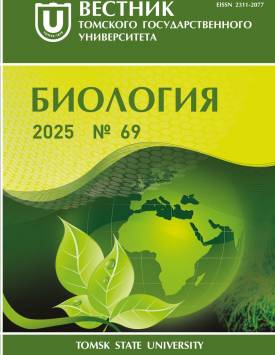Metabolic activity of heterotrophic microbial communities of floodplain lakes in the middle reaches of the Ob River
This study provides an opportunity to quantify the biogenic component of the carbon balance, its dynamics and relationship with environmental factors. This study is the first to evaluate the functioning of microbial communities in floodplain lakes in the middle reaches of the Ob River from the perspective of studying their metabolic activity in the context of seasonal and spatial environmental changes. The purpose of this work was to assess seasonal changes in the metabolic spectra of bacterial communities in water bodies of the Middle Ob floodplain. During the summer low water period (September 2023), winter low water period (snow period, March 2024) and spring flood (May 2024), functional diversity and quantitative microbiological characteristics of heterotrophic microbial communities in the surface and bottom layers of the water column of three floodplain lakes located in the vicinity of the TSU research station “Kaibasovo” (N 57.24569342272839, E 84.18459154598635), as well as the water of the Ob River itself, were studied. Functional diversity was determined using the multisubstrate testing method on 96-well Biolog Ecoplate test systems (USA) with calculation of the AWCD (average well-covered development) index. The TMC (total microbial count), obtained by direct counting of bacterial cells in a fluorescent-stained sample, was used as a quantitative characteristic. According to the nonparametric analysis of variance (Kruskal-Wallis ANOVA test, Median test), AWCD and TMC did not differ between lakes (p>0.05). Seasonal changes were revealed for AWCD and TMC (see Fig. 1). AWCD correlated (Spearman rank correlations were used, p < 0.05) with the consumption of amino acids (0.52), carbohydrates (0.54), amines (0.50) and oxycar-boxylic acids (0.62), TMC correlated with the consumption of carbohydrates (0.45) and polymers (0.63). The dynamics of AWCD were similar for the surface layer of all lakes, and did not show obvious patterns in the bottom layer. Throughout the year, higher TMC values were observed in the bottom layer, although this pattern was not observed for AWCD (see Fig. 1). This is due to the effect of ultraviolet radiation from the sun and the influence of allochthonous microflora on the current AWCD values. TMC in floodplain lakes increased during winter low water and had minimum values during the flood period. During the winter low water period, the AWCD and the consumption of most substrate groups are higher in the bottom layer. Seasonal differences in consumption of carboxylic acid phosphates (Kruskal-Wallis test: H (2, N = 18) = 10.36; p = 0.01; Median test: Chi-Square = 12.00; df = 2; p = 0.00) and polymers (Kruskal-Wallis test: H (2, N = 18) =7.18; p = 0.03; Median test: Chi-Square = 9.33; df = 2; p = 0.01) have been identified (see Fig. 2). A large number of correlations between the consumption of different groups of substrates, including within the surface and bottom layers, indicate the cosmopolitan nature and functional interchangeability of representatives of microbial communities. Moreover, during low water, when conditions are most favorable for the growth of microflora, the number of correlations was maximum (9 out of 15); during the freeze-up period it decreased significantly (4 out of 15), which may indicate a targeted growth of more specialized microflora. In May, the number of correlations increased again (5 out of 15). Seasonal changes in the functional and quantitative characteristics of microbial communities did not correspond to each other - the increase in the number of microorganisms did not cause an increase in functional diversity. The microflora suppression during flooding characterizes the demi-seasonal succession of the microbial community. Based on the data obtained, one can judge the functional cosmopolitanism and functional interchangeability of representatives of microbial communities of floodplain water bodies. The article contains 2 Figures, 12 References. To the team of the USI "System of Experimental Bases Located Along the Latitudinal Gradient" for assistance in organizing and conducting field work. The Authors declare no conflict of interest.
Keywords
heterotrophic microorganisms, functional diversity, multisubstrate test, fluvial lake, Ob river floodplain, West SiberiaAuthors
| Name | Organization | |
| Nikitkina Ellina G. | Tomsk State University | madderroot@mail.ru |
| Luschaeva Inna V. | Tomsk State University | luschaeva@mail.ru |
| Kolesnichenko Larisa G. | Tomsk State University | klg77777@mail.ru |
References

Metabolic activity of heterotrophic microbial communities of floodplain lakes in the middle reaches of the Ob River | Vestnik Tomskogo gosudarstvennogo universiteta. Biologiya - Tomsk State University Journal of Biology. 2025. № 69. DOI: 10.17223/19988591/69/15
